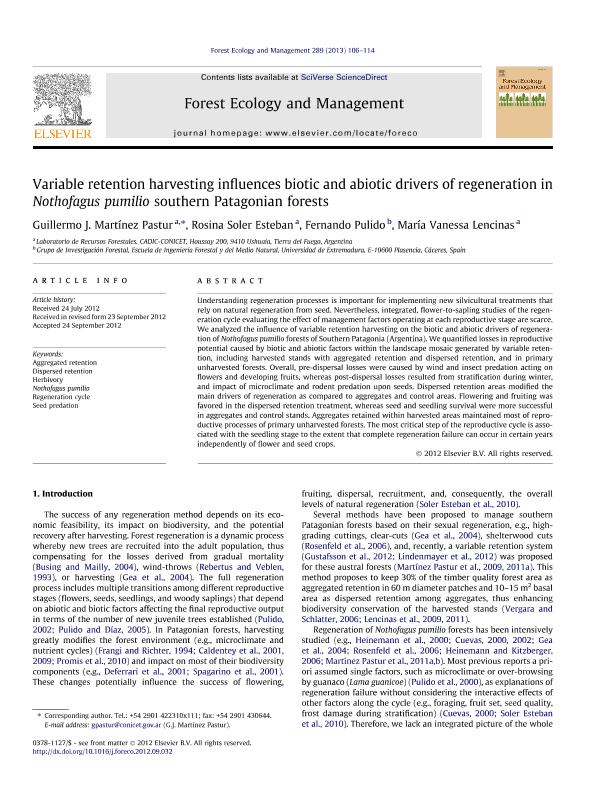Mostrar el registro sencillo del ítem
dc.contributor.author
Martínez Pastur, Guillermo José

dc.contributor.author
Soler Esteban, Rosina Matilde

dc.contributor.author
Pulido, Fernando
dc.contributor.author
Lencinas, María Vanessa

dc.date.available
2017-10-17T17:15:36Z
dc.date.issued
2013-01
dc.identifier.citation
Martínez Pastur, Guillermo José; Soler Esteban, Rosina Matilde; Pulido, Fernando; Lencinas, María Vanessa; Variable retention harvesting influences biotic and abiotic drivers of regeneration in Nothofagus pumilio southern Patagonian forests; Elsevier Science; Forest Ecology and Management; 289; 1-2013; 106-114
dc.identifier.issn
0378-1127
dc.identifier.uri
http://hdl.handle.net/11336/26717
dc.description.abstract
Understanding regeneration processes is important for implementing new silvicultural treatments that rely on natural regeneration from seed. Nevertheless, integrated, flower-to-sapling studies of the regeneration cycle evaluating the effect of management factors operating at each reproductive stage are scarce. We analyzed the influence of variable retention harvesting on the biotic and abiotic drivers of regeneration of Nothofagus pumilio forests of Southern Patagonia (Argentina). We quantified losses in reproductive potential caused by biotic and abiotic factors within the landscape mosaic generated by variable retention, including harvested stands with aggregated retention and dispersed retention, and in primary unharvested forests. Overall, pre-dispersal losses were caused by wind and insect predation acting on flowers and developing fruits, whereas post-dispersal losses resulted from stratification during winter, and impact of microclimate and rodent predation upon seeds. Dispersed retention areas modified the main drivers of regeneration as compared to aggregates and control areas. Flowering and fruiting was favored in the dispersed retention treatment, whereas seed and seedling survival were more successful in aggregates and control stands. Aggregates retained within harvested areas maintained most of reproductive processes of primary unharvested forests. The most critical step of the reproductive cycle is associated with the seedling stage to the extent that complete regeneration failure can occur in certain years independently of flower and seed crops.
dc.format
application/pdf
dc.language.iso
eng
dc.publisher
Elsevier Science

dc.rights
info:eu-repo/semantics/openAccess
dc.rights.uri
https://creativecommons.org/licenses/by-nc-nd/2.5/ar/
dc.subject
Seed Predation
dc.subject
Regeneration Cycle
dc.subject
Nothofagus Pumilio
dc.subject
Herbivory
dc.subject
Aggregated Retention
dc.subject
Dispersed Retention
dc.subject
Conservation
dc.subject.classification
Otras Agricultura, Silvicultura y Pesca

dc.subject.classification
Agricultura, Silvicultura y Pesca

dc.subject.classification
CIENCIAS AGRÍCOLAS

dc.title
Variable retention harvesting influences biotic and abiotic drivers of regeneration in Nothofagus pumilio southern Patagonian forests
dc.type
info:eu-repo/semantics/article
dc.type
info:ar-repo/semantics/artículo
dc.type
info:eu-repo/semantics/publishedVersion
dc.date.updated
2015-06-11T18:21:02Z
dc.journal.volume
289
dc.journal.pagination
106-114
dc.journal.pais
Países Bajos

dc.journal.ciudad
Ámsterdam
dc.description.fil
Fil: Martínez Pastur, Guillermo José. Consejo Nacional de Investigaciones Científicas y Técnicas. Centro Austral de Investigaciones Científicas; Argentina
dc.description.fil
Fil: Soler Esteban, Rosina Matilde. Consejo Nacional de Investigaciones Científicas y Técnicas. Centro Austral de Investigaciones Científicas; Argentina
dc.description.fil
Fil: Pulido, Fernando. Universidad de Extremadura; España
dc.description.fil
Fil: Lencinas, María Vanessa. Consejo Nacional de Investigaciones Científicas y Técnicas. Centro Austral de Investigaciones Científicas; Argentina
dc.journal.title
Forest Ecology and Management

dc.relation.alternativeid
info:eu-repo/semantics/altIdentifier/url/http://www.sciencedirect.com/science/article/pii/S037811271200583X
dc.relation.alternativeid
info:eu-repo/semantics/altIdentifier/doi/http://dx.doi.org/10.1016/j.foreco.2012.09.032
Archivos asociados
